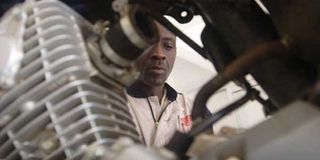Choose your garage according to the fault

If there is any wobble or judder or bounce in your car’s ride on a smooth road, however slight, don’t ignore or tolerate it. Check the cause promptly and fix it properly. PHOTO | FILE
What you need to know:
- The second is that while wheels do quite frequently go out of balance, and can be easily, accurately and safely rectified on now plentiful wheel balancing machines, if the imbalance is very severe, do take a very close look for some other fault.
- If a balancing exercise requires several large weights on either side, it’s time to change the tyre or the rim, or both.
My car recently returned from a rough and heavily laden safari in apparently good working order.
But when I unloaded it, washed it, re-set the tyre pressures and drove it on some smooth tarmac, it felt as though the road was made of squiggly corrugated iron.
There was both a distinct wobble and a pogo-stick sensation. Of the many possible causes, I started with the likelihood of severe wheel imbalance. Happily, computerised wheel balancing machines are now commonplace, and they confirmed a severe anomaly.
A perfect reading would be 0 on both sides; a score of 5 and up to 10 might be acceptable. One of my rear tyres gave imbalance readings of 130!
The garage technician said the rim must be bent (unlikely on an alloy rim that has stayed straight for more than 20 years of challenging use, and surely I would have noticed and remembered if I had hit a hole or bump harder than ever before).
Undaunted, the operator proceeded to fit half-a-bucketful of balance weights, got the readings down to a relatively modest 15 and proudly declared that he had fixed the problem.
VISIBLE MOUNDS
No he hadn’t. Watching the process, I could clearly see that the tyre was no longer round.
The tyre walls (the soft part most prone to bruising and bulges) looked smooth and symmetrical, but the tread surface had visible “mounds” on it – confirmed by holding a pointer in a fixed position a couple of millimetres off the tread surface while slowly rotating the wheel on the balancing machine. As the wheel spun, at some moments the gap got larger, and at others the pointer hit the tread.
The probable cause would be ply separation, weakening parts of the casing so the equal pressure of 30 psi stretched the tread more in some places than in others.
That may be okay as a last resort spare, at low speeds and on hair-trigger readiness for a blow out. But in normal terms, that tyre’s only safe contribution to the future will be for making shoes.
My next action will be to put a pick-axe through several places on the tyre wall so it can never again be fitted to a wheel rim or somehow find its way into the retread market. I wouldn’t even give it to a mkokoteni puller.
There are three morals to this story: The first is to ensure that if there is any wobble or judder or bounce in your car’s ride on a smooth road, however slight, don’t ignore or tolerate it. Check the cause promptly and fix it properly.
The second is that while wheels do quite frequently go out of balance, and can be easily, accurately and safely rectified on now plentiful wheel balancing machines, if the imbalance is very severe, do take a very close look for some other fault. If a balancing exercise requires several large weights on either side, it’s time to change the tyre or the rim, or both.
The third is that state-of-the-art workshop equipment is an advantage only if it is used by a well-trained operator.
Choose your garage accordingly.





